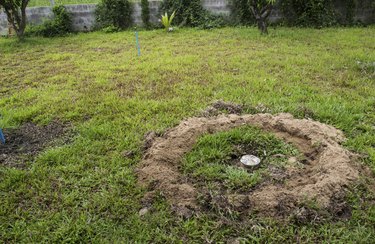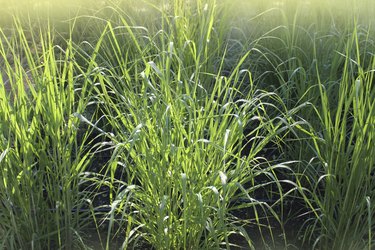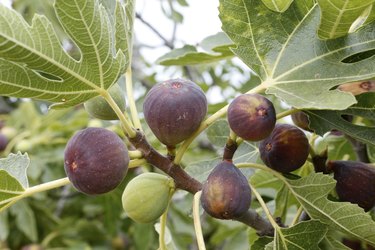
Landscaping around septic systems requires a careful balance between concealing unsightly risers and other above-ground components, and maintaining easy maintenance access. Plants for concealing risers must be shallow rooted, drought tolerant and low-maintenance to avoid disturbing the soil with regular tending. Perennials are the best choice since annuals require the soil to be re-worked every year. Remember to wear gloves when working the soil on and around septic systems, and wash your hands after landscaping.
Ornamental Grasses
Video of the Day

Grasses are sturdy, low-maintenance plants that work well around a septic systems, and several ornamental species grow tall enough to conceal a septic riser. Switchgrass (Panicum virgatum) grows 3 to 7 feet tall and is hardy in U.S. Department of Agriculture plant hardiness zones 4 through 8. Northern Sea Oats (Chasmanthium latifolium) reaches 2 to 3 feet tall and is hardy in USDA zones 3 through 9. Before planting grasses or other plants, obtain an "as-built" drawing of your septic system so you know how all the components are laid out in the yard. These are typically on file at the department of public health.
Video of the Day
Perennial Wildflowers

The ground on top of septic tanks and near the risers is shallow and dry. Drought-tolerant native wildflowers typically grow well near septic systems. Two examples of North American wildflowers are tickseeds and coneflowers. Large flowered tickseed (Coreopsis grandiflora) grows 1 to 2 feet tall and produces yellow flowers. Purple coneflower (Echinacea purpurea) is bushier and grows 2 to 4 feet tall, with purple daisy-shaped flowers. These species are hardy in USDA zones 3 through 8. When planting these and other flowers, remember to leave paths for access to the septic risers.
Sturdy Shrubs

Shrubs can be used to conceal septic risers but must be planted about 10 feet from the septic tank. Planted alongside wildflowers and grasses, they block the view of a riser while still leaving space for maintenance on the septic tank. The Nanking or Manchu Cherry (Prunus tomentosa) is a flowering shrub hardy in USDA zones 3 through 6 that can tolerate extreme cold and drought. It grows 8 to 9 feet high with a 15-foot spread. Bayberry (Myriac pennsylvanica) is hardy in USDA zones 4 through 9, and its semi-evergreen leaves and gray berries help conceal septic tanks in the winter. It is a rounded 8- to 9-foot tall shrub.
Plants to Avoid

When landscaping around a septic tank, the plants you avoid are just as important as the plants you choose. Since the septic system is processing household waste, do not plant any fruits, vegetables or herbs that will be used for food near a septic system. Water-loving species should be avoided as well since their roots will aggressively seek out moisture and can damage the septic system. For much the same reason, avoid planting trees close enough that their roots can grow into the septic system. Keep trees 20 to 50 feet away, with larger trees farthest away, from every part of the septic system.
- Public Health - Seattle & King County: Landscaping Tips With A Septic System
- Kentucky Cooperative Extension: Native Plant Landscaping of Septic Systems
- Washington Sea Grant Program: Landscaping Your Septic System
- University of Illinois Extension Ornamental Grasses: Switchgrass
- University of Illinois Extension Ornamental Grasses: Northern Sea Oats
- Cornell University Coopertive Extension: Shrubs For Difficult Sites